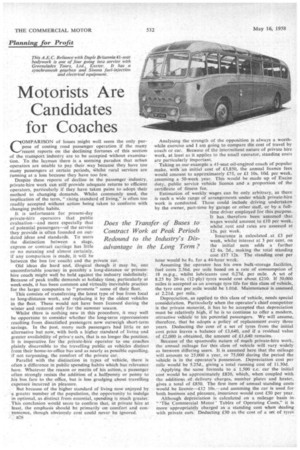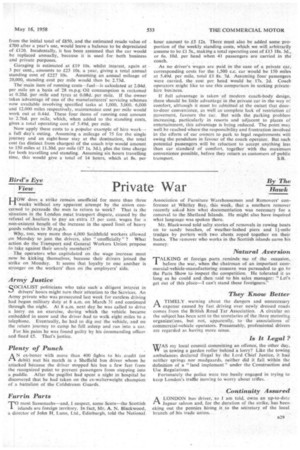Motorists Are Candidates for Coaches
Page 60

Page 63

If you've noticed an error in this article please click here to report it so we can fix it.
C' OMPARISON of losses might well seem the only purpose of costing road passenger operation if the many recent reports on the declining fortunes of this section of the transport industry are to be accepted without examination. To the layman there is a seeming paradox that urban operators are unable to pay their way because they have too many passengers at certain periods, N-vhilst rural services are running at a loss because they have too few.
Despite these reports of decline in the passenger industry, private-hire work can stilt provide adequate returns to efficient operators, particularly if they have taken pains to adopt their method to changing demands, Whilst commonly used, the implication of the term, "rising standard of living," is often too readily accepted without action being taken to conform with changing public habits.
It is unfortunate for present-day private-hire operators that public evaluation—and more especially that of potential passengers—of the service they provide is often founded on outdated ideas and standards. To users the distinction between a stage, express or contract carriage has little or no meaning and almost certainly, if any comparison is made, it will be between the bus (or coach) and the private car.
Old ideas die hard and, illogical though it may be, one uncomfortable journey in possibly a long-distance or privatehire coact might well be held against the industry indefinitely. Because of peak traffic demands at holiday time, particularly at week-ends, it has been common and virtually inevitable practice for the larger companies to "promote" some of their fleet.
This consists of transferring the latest type of bus from local to long-distance work, and replacing it by the oldest vehicles in the fleet, These would not have been licensed during the winter and restored only for the summer season.
Whilst Were is nothing new in this procedure, it may well be opportune to consider whether the long-term repercussions resulting from dissatisfied passengers now outweigh short-term • savings. In the past, many such passengers had little or no alternative but now, with both a higher standard of living and greater availability of priva'e cats, that is no longer the position. It is imperative for the private-hire operator to use coaches plainly discernible to the travelling public as vehicles distinct from their home-to-office bus and as nearly as possible equalling, if not surpassing, the comfort of the private car.
Parallel with the distinction in types of vehicle, there is often a difference in public spending habits which has relevance here. Whatever the reason or merits of his action, a passenger often strongly resists the addition of a halfpenny or penny to his bus fare to the office, but is less grudging about travelling expenses incurred in pleasure.
But because of the higher standard of living now enjoyed by a greater number of the population, the opportunity to indulge in optional, as distinct from essential, spending is much greater. This conclusion would seem to confirm that, in private hire at least, the emphasis should be primarily on comfort and convenience, though obviously cost could never be ignored. Analysing the strength of the opposition is always a worthwhile exercise and I am going to compare die cost of travel by coach or car. Because of the intermittent nature of private hire work, at least as it applies to the small operator, standing costs are particularly important.
Taking as our example a 41-seat oil-eng„ined coach of popular make, with -an initial cost of £3,850, the annual licence fees would amount to approximately £75, or £1 10s. 10d. per week, assuming a 50-week year. This would be made up of Excise duty, public service vehicle licence and a proportion of the certificate of fitness fee.
Estimation of weekly wages can be only arbitrary, as there is such a wide range of arrangements under which private-hire work is conducted. These could include driving undertaken by the owner, part-time by garage or other staff, or by a full time driver employed for this purpose.
It has therefore been assumed that wages would amount to £10 per week, whilst rent and rates are assessed at 15s. per Week.
Insurance is calculated at £3 per week, whilst interest at 3 per cent. on the initial sum adds a further 12 6s. 2d., making the total standing cost £17 12s. The standing cost per hour would be 83. for a 44-hour week.
Assuming the operator has his own bulk-storage facilities, fuel costs 2.56d. per mile based on a rate of consumption of 18 m.p.g., whilst lubricants cost 0.27d. per mile, A set of 8.25 by 20-in. (12-ply) tyres would cost about £210. If 50.000 miles is accepted as an average tyre life for this class of vehicle, the tyre cost per mile would be 1.0Id. Maintenance is assessed, at 2.21d. per mile.
Depreciation, as applied to this class of vehicle, needs special consideration. Particularly when the operator's chief competitor is the private motorist, it has to be accepted that depreciation must be relatively high, if he is to continue to offer a modern, attractive vehicle to his potential passengers. We will assume, therefore, that he adopts a policy of replacement every three years. Deducting the cost of a set of tyres from the initial cost price leaves a balance of 13,640, and if a residual value of £2,000 is obtained, the amount of £1,640 remains.
Because of the spasmodic nature of mnch private-hire work, the annual mileage for this class of vehicle will vary widely as between differing users. It is assumed here that the mileage will amount to 25,000 a year, or 75,000 during the period the vehicle is in the operator's possession. Depreciation cost per mile would be 5.25d., giving a total running cost of 11.30d.
Applying the same formula to a 1,500 cc. car the initial cost would be approximately £820, which, when coupled with the additions of delivery charges, number plates and heater, gives a total of 1850. The first item of annual standing costs would be licence—l2 10s.--and assuming the car is used, for both business and pleasure, insurance would cost 150 per year.
Although depreciation is calculated on a mileage basis in 'The Commercial Motor' Tables of Operating Costs," it is more appropriately charged as a standing cost when dealing with private cars. Deducting £30 as the cost of a set of tyres from the initial total of £850, and the estimated resale value of £700 after a year's use, would leave a balance to be depreciated of £120. Incidentally, it has been assumed that the car would be replaced annually, because it is used for• both business and private purposes. • Garaging is estimated at £19 10s. whilst interest, again at 3 per cent., amounts to £25 10s. a year, giving a total annual standing cost of £227 10s. Assuming an annual mileage of 20,000, standing cost per mile would then be 2.73d.
The main item of running costs—fuel—is calculated at 2.04d. per mile on a basis of 28 m.p.g. Oil consumption is reckoned at 0.20d. per mile and tyres at 0.08d. per mile. If the owner takes advantage of one of the manufacturers' servicing schemes now available involving specified tasks at 1,000, 3,000, 6,000 and 12.000 miles respectively, maintenance cost per mile would work out at 0.44d. These four items of running cost amount to 2.76d. per mile, which, when added to the standing costs, gives a total operating cost of 5.49d. per mile.
Now apply these costs to a popular example of hire work-a full day's outing. Assuming a mileage of 75 for the single journey and an eight-hour stay at the destination, the total cost (as distinct from charges) of the coach trip would amount to 150 miles at 11.30d. per mile (£7 Is. 3d.), plus the time charge for both travelling and standing. Assuming six hours travelling time, this would give a total of 14 hours, which at 8s. per hour amount to 15. 12s. There must also be added some proportion of the weekly standing costs, which we will arbitrarily assume to be El 5s., making a total operating cost of £13 18s. 3d., or fis. 10d, per head when 41 passengers are carried in the coach. • As no driver's wages are paid in the ease of a private car, corresponding costs for the 1,500 c.c. car would be 150 miles at 5.49d, per mile, total 13 8s. 7d. Assuming four passengers were carried, the cost per head would be 17s. 2d. Coach operators might like to use this comparison in seeking privatehire business.
If full advantage is taken of modern coach-body design, there should be little advantage in the private car in the way of comfort, although it must be admitted at the outset that doorto-door convenience, as well as complete lack of restriction of movement, favours the car. But with the parking problem increasing, particularly in resorts and adjacent to places of entertainment, this advantage is being reduced. The point may well be reached where the responsibility and frustration involved in the efforts of car owners to park to legal requirements will swing the pendulum in favour of the coach operator. But such potential passengers .will be reluctant to accept anything less than car standard of comfort, together with the maximum convenience possible, before they return as customers of public
transport. S.B.




































































































